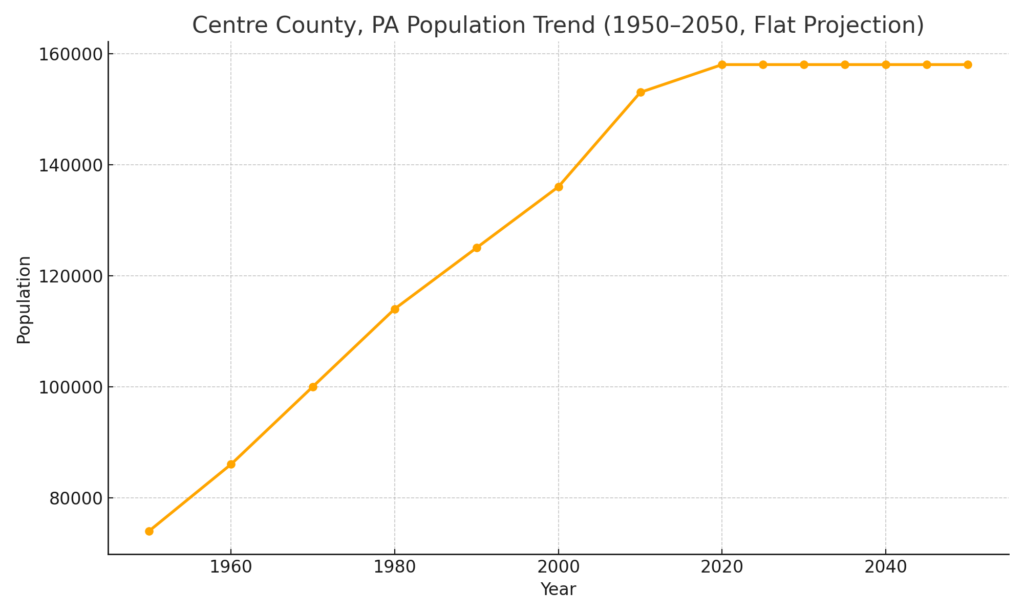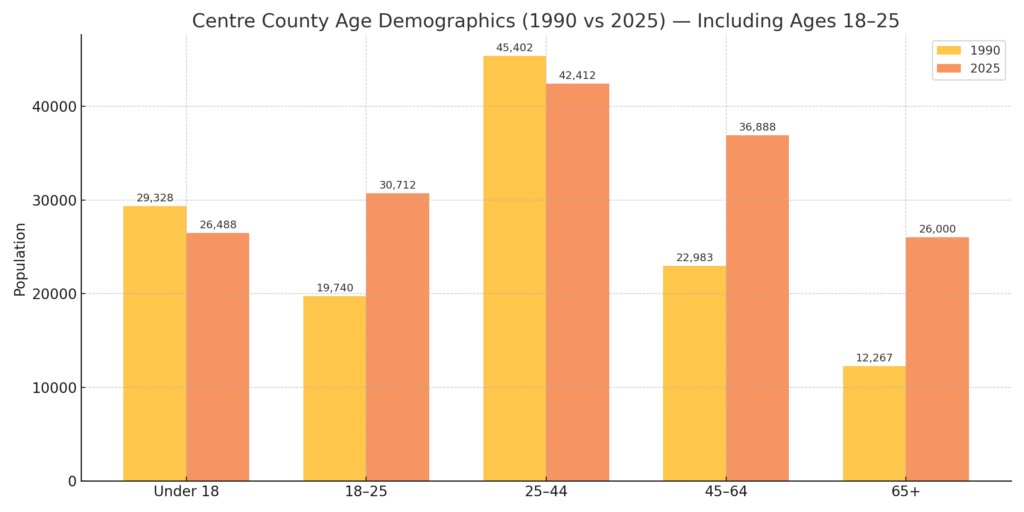75 Years of Growth — Then a Plateau
Centre County experienced steady population growth for much of the 20th and early 21st centuries. However, recent data shows that growth has slowed significantly:

- 1950: 74,026
- 1970: 98,144 (+32.5%)
- 1990: 123,786 (+26.2%)
- 2010: 153,990 (+24.4%)
- 2018 (peak): 161,960
- 2020: 158,172 (-2.3%)
- 2023: 158,234 (+0.04%)
- 2025 (est.): 158,319
According to the Pennsylvania State Data Center, Centre County’s population is projected to remain relatively stable through 2050, with modest growth possible depending on regional trends.
Demographic Shifts (1990–2025)

Centre County’s population is aging, while younger age groups are declining:
- 65+ population:
- 1990: 8.7% (~12,300)
- 2025: 16% (~26,000)
- Change: +111%
- Under 18 population:
- 1990: 20.8%
- 2025: 16.3%
- Change: ~6,700 fewer children (-22%)
- Ages 25–44:
- 1990: 32.2%
- 2025: 26.1%
- Change: ~9,150 fewer working-age adults
- Ages 45–64:
- 1990: 16.3%
- 2025: 22.7%
- Change: ~9,550 more residents
Workforce and Housing Snapshot
- Workforce residency:
- 54% of employees live and work in Centre County
- 46% commute in
- Median household income (2023):
- $70,642 (below Pennsylvania state average)
- Housing affordability:
- Limited availability of homes under $300,000
- Labor market trends:
- Increased use of AI and automation in entry-level roles
Planning Landscape
There is currently no single countywide strategy to address population trends. Responsibility for long-term planning is shared among:
- Centre County Commissioners
- Municipal and borough councils
- Chamber of Commerce
- Penn State University
- Private sector employers
- Nonprofits and planning agencies
College Towns Planning for Growth
While Centre County’s population is projected to remain stable, several other U.S. college towns are actively planning for growth:
| Town | University | Projected Growth |
| Bozeman, MT | Montana State University | +140% by 2050 |
| Provo, UT | Brigham Young University | +50% by 2050 |
| Gainesville, FL | University of Florida | +20–25% by 2045 |
| East Lansing, MI | Michigan State University | +10–15% by 2045 |
| Ann Arbor, MI | University of Michigan | +15–20% by 2045 |
Other college towns are planning for growth. Why aren’t we? And who decides if we should grow or maybe we liked Happy Valley better in the 1980’s?







6 Responses
We have too many municipalities (fiefdoms) in Centre County that effecting planning is a long and arduous process. We need mergers and consolidations.
Hi Tom,
Thanks for your note—What actually triggers these kinds of marketplace-level decisions to consolidate or merge?
Is it purely financial pressure? Political courage? A crisis point? Or does it require a shared, strategic vision that enough stakeholders can rally around?
I’ve looked into some historical examples in other communities, and many seem to act only when forced — by insolvency, declining tax base, or infrastructure failure. But I wonder: Do we have to wait for that level of stress? Or can alignment happen earlier when the case for efficiency and regional impact is clear?
Curious if you’ve seen any local examples where consolidation or shared services worked, or if you know of leaders quietly trying to push in that direction here.
Interesting. I would like to see consolidation. Seems like Too many groups with too many agendas.
I’ll be following this with interest. At some point I’ll want to sell my house. Growth would help that!!
Our multitude of townships and boroughs are largely a product of the 19th and early 20th century when there were different transportation and communication capabilities and a different attitude towards government. Things have changed drastically in the last 100 years. We’ve become stuck in our ideas about keeping the status quo. Centre region consolidation can’t even get on the ballot to study.
It’s the regional councils of government that have taken the place of consolidated municipalities. B Therr are planning agencies at the county, regional and municipal levels. But Pennsylvania seems to resist planning for growth compared to many states like Virginia and Florida. We never build infrastructure to anticipate growth. Instead, we’re always trying to mitigate problems after growth has happened. Our local governments and the communities seem to have a strong NIMBY attitude toward growth. Despite pro-growth agencies, people here more often see growth as a problem vs. preserving our rural character and natural environment. No wonder population has plateaud.
Thanks for the comments! The benefits of a discussion. Opened up my eyes….
Here are Centre County’s 35 Municipalities:
6 Boroughs: State College, Bellefonte, Centre Hall, Howard, Millheim, Milesburg
29 Townships: Benner, Boggs, Burnside, College, Curtin, Ferguson, Gregg, Halfmoon, Haines, Harris, Howard, Huston, Liberty, Marion, Miles, Patton, Penn, Potter, Rush, Snow Shoe, Spring, Taylor, Union, Walker, Worth — and others with overlapping influence
That’s not counting regional authorities like CATA, the Centre Region Council of Governments (COG), Planning Commissions, or countless nonprofits and economic development agencies.
Most of the region’s citizens are still fiercely opposed to consolidation … me too! Central Planning rarely, if ever, works for the direct benefit of the people. It does add additional layers of infrastructure and the corresponding costs (taxes) associated with that bureaucracy, while silencing the voices and self-government the minority/under-represented townships currently enjoy. In the end, State College Boro would rule, and the currently independent townships and municipalities would be forced to contribute to the fiscally irresponsible boro deficits. If you want an example of how to mismanage growth and progress, drive or walk through the wasteland of downtown State College and contemplate why there are fewer businesses and why many more are planning to leave. It’s the worst-kept secret in the county.